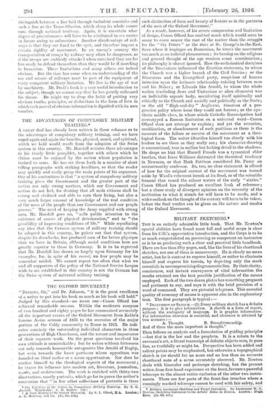THE OXFORD MOVEMENT.t " BEstnEs, Sir," said Dr. Johnson, "
it is the great excellence of a writer to put into his book as much as his book will hold." Judged by this standard—no mean one—Canon 011ard has achieved remarkable success. Within the moderato compass of two hundred and eighty pages ho has summarized accurately all the important events of the Oxford Movement from Keble's famous Assize sermon of 1833 to the secession of the major portion of the Caldy community to Rome in 1013. He indi- cates concisely the outstanding individual characters in three generations of High Churchmen, and the nature and importance of their separate work. On the great questions involved his own attitude is unmistakable ; but he writes without bitterness not only towards honourable antagonists like Arnold of Rugby, but even towards the baser partisans whose opposition was , founded on blind malice or a mean opportunism. Nor does he confine himself to the theological aspects of the movement ; he traces its influence into modern art, literature, journalism, mimic, and architecture. The work is enriched with thirty-two illustrations, mostly portraits, which go far to prove the author's contention that " in few other collections of portraits is there
• The Upliftiny of the Nation by Compulsory Military Training. By T. 0. -.torsion. Nanchaster : C. H. Barber. [24.] t A Short history At the 04ord Movement. By S. L. Maid, Y.A. London; A. it. Mowbray and Co. [4s„ 64. net.]
such distinction, of lorm and beauty of feature as in the poraits. of the men of the Oxford Movement.7
As a result., howevor,.of his severe compression and limitation of design, Canon 011ard has omitted much which would seem to many to come nearer the root of the matter than. the struggle for the " Six Points " or the riots at St. George's-in-the-East. Save where it impinges on Romanism, he treats the movement too much as an isolated phenomenon ; its bearing on the religious and general thought of the age receives scant consideration; its philosophy is almost ignored. How the ecclesiastical doctrines of the Tractarians influenced the Erastian statesmen, to whom the Church was a higher branch of the Civil Service ; or the Dissenters and the Evangelical party, suspicious of human intrusion upon the intimate relationship existing between man and his Maker ; or Liberals like Arnold, to whom the whole nation (excluding Jews and Unitarians as alien elements) was an indivisible organic body, manifesting itself spiritually and ethically as the Church and socially and politically as the State; or the old " High-and-dry " Anglicans, timorous of a pro- gressive policy whose issue they could not foresee ; or the apa- thetic middle class, in whose minds Catholic Emancipation had stereotyped a Roman limitation on a universal word—Canon Marti does not attempt to explain ; and yet the retention, modification, or abandonment of such positions as these is the measure of the failure or success of the movement as a theo- logical force. The writer identifies himself too closely with his leaders to see them as they really are ; his character-drawing is conventional, true in outline but lacking detail in the shadows. He drops no hint that. Hurrell Freud° was a tyrannical elder brother, that Isaac Williams distruatcd the theatrical tendency in Newman, or that Mark Pattison considered Dr. Posey an untrustworthy confessor. So, too, no clear statement is offered of how far the original current of the movement was turned aside by Ward's vehement inrush at its flood, or of the scientific ferment that vexed the calmer waters of the early " sixties." Canon 011ard has produced an excellent book of reference ; but a closer study of divergent opinions on the necessity of the institution to what it stands for will have to be made, and a wider outlook on the thought of the century will have to be taken, before the final verdict can be given on the nature and results of the Oxford Movement.


































 Previous page
Previous page